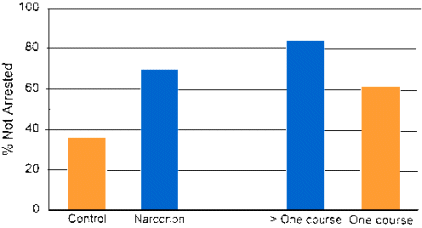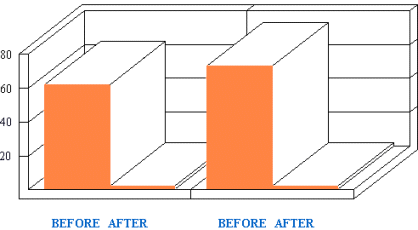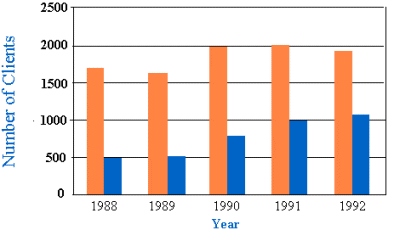

| 1-800-871-4350 |
 |
 |
 |
 |
 |
 |
 |
 |
 |
 |
| NARCONON FACTS |
|
Family members often try to protect an addict from the results of his behavior by making excuses to others about his addiction problem and by getting him out of drug-related jams.
Intervention is a process that helps an addict recognize the extent of his problem. Narconon graduates are brought back to life, confident, in control and able to achieve their goals without the use of drugs. Narconon provides a specific course of drug rehabilitation treatment which includes training in communication, a full body detoxification process, counseling in problem identification and solving, as well as counseling in personal values and integrity. |
| RESOURCES |
 |
Narconon
Overview
Narconon Evaluation
The Narconon Solution
What
exactly is this program that Kirstie Alley and Kelly Piper credit with saving
their lives? Narconon began 30 years ago in an Arizona state prison, when inmate
William Benitez sought to cure himself of drug addiction. He relied on methods
developed by American philosopher and humanitarian L. Ron Hubbard, and he corresponded
with Mr. Hubbard during that process.
Benitez was successful, and his success
led to the expansion of the program, first within the prison and then to actual
Narconon centers. The first opened in Los Angeles in 1971.
Today, Narconon is administered by Narconon International in Los Angeles, which operates in 38 locations in the United States, Canada, Spain, Italy, Switzerland, France, Germany, Holland, Sweden, Denmark, England and Russia. The program has freed more than 25,000 people from drug addiction.
Its drug-free withdrawal, detoxification and rehabilitation procedure utilizes methods developed by Mr. Hubbard and is officially recognized in many countries as the most effective drug rehabilitation available. Several governments provide funding and support for Narconon.
Narconon utilizes an exact series of drills, exercises and study steps which enable an addict to “kick his habit” and assist the person to address the problem areas in his life which led to his addiction. It also utilizes Mr. Hubbard’s discovery that residues of drugs and toxins lodge in the fatty tissues of the body and stay there for years after they have been ingested—and a revolutionary program to remedy this plight.
Further steps in the program include a series of communication drills which assist the person to improve his relationships, a course which teaches the basics of how to study and courses to help the person deal with the various situations in his life. The result is a person who knows he is free from drugs and drug residuals and from any desire to take drugs again.
Results of the Narconon� Program: An Overview of Findings
December,
1994
Prepared by Shelley L. Beckmann, Ph.D.

The Narconon Program vs. Traditional Treatment
The
Narconon program addresses all aspects of addiction, with the result being that
76% of those graduating the Narconon program are drug-free two years later. This
is in contrast to the 16%-20% of more traditional programs.
Results
of the Narconon�Program: Key Findings
Incarcerated Populations:
The Narconon program was originally set up for incarcerated populations. The program has been delivered in a variety of institutional settings. Several means of monitoring the programs' effects have been used:
1) Parolees who had taken Narconon program courses at the California Dept. of Corrections, The California Institute for Women, the Arizona Correctional Authority and Riker's Island Institute for Men in New York were tracked.
On average, 73% of Narconon program clients released from prison remained clean while on parole.
2) Youth at the Youth Training School of the California Youth Authority had the opportunity to participate in a Narconon program. The behavior of youth at the facility was monitored by the number of infractions, the number of restrictions, and the grade being achieved in trade school.
Those youth who participated in the Narconon program showed positive changes in each of these measures compared to other youth at the same facility who did not participate. In fact, the number of infractions and the number of restrictions of non-participants increased while the numbers for Narconon program clients decreased.
3) Narconon program clients at the State Reformatory for Men in Minnesota showed improvements in the number of rule infractions of which they were found guilty, of the days of lost privileges, and the days of segregation. These changes were evident during both program delivery and follow up time periods.
4) Parolees from the Delaware Correctional Center were tracked. 70% of the Narconon program clients had no arrest during the follow up period, compared to 36% of the control population.
Residential Programs:
Narconon programs have been delivering services to non-incarcerated populations since 1972.
1) In surveys of graduates from four facilities located in Connecticut, Boston, West Berlin and Sweden, employment was almost doubled, arrests were greatly reduced, and the vast majority (as much as 90%) reported that they were no longer using drugs.
2) In a study conducted in Spain, over 75% of graduates remained free of drugs. Whereas almost 90% had been actively involved with crime before the Narconon program, none were involved with crime afterwards.
The Narconon program is effective, both in reducing drug abuse and in improving the behavior of clients.
1. Introduction:
The Narconon organization is a public benefit, non-profit, 501(c)(3) corporation that is committed to the elimination of substance abuse. Founded in 1966, Narconon centers have supplied drug rehabilitation treatment and education/prevention services for 28 years. The Narconon approach is based on techniques developed by author and philosopher L. Ron Hubbard.
Each component of the Narconon program is designed to increase the abilities of the client. The initial program included courses and drills designed to increase the client's communication skills, study skills and orientation to the environment. Over the years the program has expanded to address additional needs of the substance abuser. The Narconon program now includes drug-free withdrawal, detoxification, and specific courses designed to increase the client's communication skills, study skills, orientation to the environment, understanding of moral principles, and preparation for work.
The Narconon program was founded in Arizona State Prison and initially expanded predominately to other prison facilities. In 1972, Narconon centers began delivering services to the public at its first residential facility in Los Angeles. There are currently 37 Narconon facilities worldwide. The majority of these facilities provide drug rehabilitation services to the public in a residential setting.
2. Results of the Narconon� Program in the Prison Setting:
Several evaluations of the Narconon program have been conducted. Evaluations of Narconon programs being delivered to incarcerated populations have focused on objective measures of behavior, including the involvement of clients with the criminal justice system during and after parole.
Surveys of Narconon� Program Graduates:
Simple tabulations of the behavior of parolees were done in several institutions in the 1970's:
A) The California Dept. of Corrections reported on 19 inmates who had participated in the Narconon program while in prison. 17 had been paroled. 12 of these were reported as clean (70%). Of the five remaining, 2 were not found, 2 had been arrested and one was suspended due to cocaine use.
B) In a study conducted in Spain, over 75% of graduates remained free of drugs. Whereas almost 90% had been actively involved with crime before doing the Narconon program, none were involved with crime afterwards.
C) The California Institute for Women reported on 25 Narconon clients. 23 had been paroled. 18 of these were clean (78%). Of the remaining, 3 were parolees at large and 2 had been arrested.
D) The Arizona Correctional Authority reported on 76 Narconon clients who had been released from prison. 32 were found. 24 of these were clean (75%).
E) The Narconon organization's Executive Director compiled a report on Narconon clients at the Riker's Island Institute for Men in New York. Of the 81 clients who had started the voluntary course, 43 had completed the initial program. 21 of these had been paroled and 17 were contacted. 14 of these were clean (82% of those found, 67% of total parolees).
Overall, around 73% of the Narconon clients released from prison remained clean while on parole in these follow up surveys.
Evaluations of the Narconon� Program:
California Youth Authority:The effectiveness of the Narconon program in changing behavior was studied at the Youth Training School (YTS) of the California Youth Authority. This study was aimed at monitoring objective measures of behavior. Therefore, the evaluators tabulated the number of infractions, the number of restrictions, and the grade being achieved in trade school.
Narconon program clients were defined as those students who regularly attended meetings for one to four months. Controls had not participated in the Narconon program. 14 clients were compared to 27 randomly selected controls.
On average, the youth participating in the program had been at the Youth Training School for 5 months prior to program start. They continued at the school for 4 to 8 months. Therefore, the three measures were compared for the first 5 months versus the balance of the school program for both Narconon clients and controls. This comparison was designed to assess any change in behavior following the Narconon program.
Table I shows the average finding for each of these measurements. Both the number of infractions and the number of restrictions for Narconon clients decreased, on the average, after starting the program. In comparison, the number of infractions and restrictions increased for the control group of YTS wards.
The average grade in trade school for both Narconon clients and the control group increased over the course of the program. The increase in grade level was more pronounced for those in the Narconon program.
As Dan Fauchier, of the Youth Authority, stated: "[the survey] results should not be viewed as positive proof of the Narconon program's effectiveness, they do seem to strongly indicate that the Narconon program is having a very positive and beneficial effect in increasing the socially-desirable behavior of its participants both in trade classes and on the living units."
TABLE
I
Study of Narconon Program Clients at the Youth Training School in California
| Up
to 5 Months | After
5 Months | |
| (Pre
Narconon Program) | (Post
Narconon Program) | |
| Number
of Infractions (average) | ||
| Narconon Program Clients | 2.6 |
1.4 |
| Controls |
1.5 |
2.7 |
| Trade
School Grade (average) | ||
| Narconon Program Clients | C- |
B |
| Controls |
C |
C |
Minnesota Reformatory:Narconon program clients at the State Reformatory for Men in Minnesota were evaluated by Posthumos and Snowden in 1978. The authors chose to evaluate the change in behavior of Narconon clients with time, considering the pre-treatment behavior pattern as the control for this population. These authors were also interested in monitoring objective measures of behavior. The measures available, which the institute monitored as part of its standard operation, included:
(1)
Institutional rule infractions that the inmates were found guilty of,
(2) Days
of lost privileges, and
(3) Days of segregation.
The number of infractions were tabulated for the 6 months prior to treatment, the time during treatment and the 6 months after treatment with the Narconon program. These results are reported as the number of infractions per 100 inmates per 30 day period.
There was a marked reduction in all measures during treatment with the Narconon program (Table II). During treatment, guilty findings were reduced by 38%, days of lost privileges were reduced by 35%, and days of segregation were reduced by 53%.
During follow-up there was also an improvement in these measures, though less than that observed while on the program. Guilty findings were reduced by 40%, days of lost privileges by 15% and days of segregation by 28%. The decrease in guilty findings was statistically significant (p<0.01) during both treatment and follow up.
TABLE
II
Results of the Narconon� Program in Minnesota
Compiled by Researchers
at the State Reformatory for Men
| Clients (36) | Pre (6 mo.) | During | Post (6 mo.) |
| No. Guilty Findings* | 48 | 30** | 29** |
| Days Lost Privileges | 274 | 177 | 232 |
| Days Segregated | 552 | 257 | 395 |
** Statistically significant improvement (p <0.01)
For comparison, a tabulation of 10% of the prison population, randomly selected, was also done. Measures were tabulated for an initial 3 months and compared to a later 3 month period. In contrast to the findings for Narconon program clients. each of these measures increased with time in the average prison population. The number of guilty findings increased by 77%, the days of lost privileges by 169% and the days of segregation by 26%. The Narconon program was effective in reversing this negative trend.
There was a difference between the Narconon program participants and the general prison population. The Narconon program attracted more property offenders than personal offenders. Whereas the prison population included 58% personal and 42% property offenders, the Narconon program clientele included 33% personal and 58% property offenders. The Narconon program was especially effective at reducing the above negative measures in property offenders while they were on the program. Long term, however, both property and personal offenders benefited approximately equally.
This study also compared the results of the program in its first and second 6 months of operation. The results improved in the second 6 months as the treatment staff became more familiar with the prison population.
The Narconon program delivered in the Delaware Correctional Center was evaluated in 1975. The Narconon program clients were, on average, more violent and were serving a longer term than the average for the population. The mean sentence was 5 years for Narconon clients versus less than one year for the total population. 58% of Narconon clients were incarcerated for a major crime whereas 23% of the total population were incarcerated for a major crime.
Narconon� Program Graduates Arrest Rate:
The arrest rates for Narconon program graduates following release were compared to the rates for a randomly selected group of parolees. The Narconon program group was composed of all graduates of the communication course who had been paroled. Of the 86 Narconon program parolees, 4 were not found and 2 were dead. Therefore the treated population consisted of 80 clients.
The control group was composed of the first 100 parolees released following the mean date for release of the Narconon program clients. Two were excluded as they had done part of the Narconon program and 11 were not found. The control group comprised 87 individuals.
Deleware
Correctional Center: Parolees Not Arrested
Figure 1: Deleware Parolees not arrested after release.
70%
of the Narconon program clients had no arrest during the follow up period, compared
to 36% of the control population. (Figure 1)
Further, the amount of training the Narconon program clients had completed was positively correlated with successful rehabilitation. 84% of those clients who had done one or more courses beyond the communications course had no further arrest compared to 62% for those who had completed only the communications course. (Figure 1)
These findings support the concept that the Narconon program is effective in bringing about positive behavioral changes in the incarcerated population.
3. Evaluations of Narconon� Residential Programs:
Survey of Program Results
The Narconon program has been delivering services to non-incarcerated populations since 1972. Currently, the majority of the Narconon programs deliver drug rehabilitation services to the public in residential facilities. The main criteria tracked in surveys have been the number of clients off drugs, involvement with the criminal justice system, and employment status. The results of several surveys of Narconon program clients are shown in Table III.
TABLE
III
Evaluations of the Narconon� Program, Delivered to Public Populations
| Drug |
Use |
Arrests | ||||
| Location |
Group |
Number |
Before |
After |
Before |
After |
| Connecticut | Clients | 10 | 10 | 2 | 0 | |
| Control* | 10 | 10 | 8 | 5 | 3 | |
| West Berlin | Clients | 20 | 20 | 0 | 12 | 1 |
| Control | 20 | 20 | 19 | 14 | 7 | |
| Drug
| Use |
Employed | ||||
| Location |
Group |
Number |
Before |
After |
Before |
After |
| Boston | Clients | 11 | 11 | 1 | 3 | 6 |
| Control | 11 | 11 | 11 | 4 | 4 | |
* Contacted the Narconon program, but did not start program.
The Connecticut survey was done shortly after program completion, the West Berlin study 7 months after graduation, the Boston study shortly after program completion, and the Sweden study four years after program completion.
In each of these surveys, the majority of the Narconon program graduates were no longer using drugs. Where monitored, their involvement with the criminal justice system had lessened and their employment improved.
The Narconon program appears beneficial in both reducing drug abuse and reducing involvement with crime.
Therapeutic Evaluation:
These results align with an independent study of the Narconon facilities done in Spain in 1985. In this study, an independent sociology group called Teenicos Asociados de Investigacion y Marketing (TAIM) evaluated the Narconon program. TAIM had also done studies on drug issues for the Ministry of Health, the Social Services Department of the Town Hall of Madrid, and the National Institute of Social Services of the Ministry of Labor and Social Security of Spain.
The Spanish study showed that 78.4 percent of the people who completed the Narconon program remained off drugs. Overall, 69.2 percent of the people contacted (including those who had not graduated) were still off drugs.
TAIM
Study: Drug Use and Crime of Clients 
Figure 2: TAIM Study - Change in Drug Use and Involvement
with Crime after Graduation.
Crime:
The Narconon program also had a profound effect on the criminal activities of clients. Before doing the Narconon program, 62.2 percent of the participants admitted having committed robberies and 73 percent had been dealing drugs. Only 10.8 percent of the participants did not previously engage in criminal activity. The study revealed that no criminal activities were reported by any of the Narconon program graduates after graduation.
Regarding relationships with their families, 67.6 percent of Narconon program graduates said that their family situation was now much better, 29.7 percent said that it had changed for the better and only 2.7 percent said that it was the same. No one stated that it had changed for the worse.
Evaluation of Recent Narconon� Program Graduates.:
Narconon program clients generally take from three to five months to complete the program, though some take significantly longer and a few have completed the program in two months. Each step is designed to address an area that virtually all substance abusers need to improve. The order of components is carefully laid out to utilize prior tools and prepare the student for the next step. The ideal situation is that every Narconon program client completes the full program.
Narconon
International: Clients Treated/Program Graduates
Figure 3: Portion of clients completing the program. Figure shows the total number of clients for the years 1998 through 1992 along with the total number graduating from the program in these years.
The percentage of program completions is therefore an important measure of the success of this program. The number of clients completing the program internationally in 1990 was 789 (39% of starts), in 1991 was 1,019 (51% of starts) and in 1992 was 1,084 (56% of starts). (see Figure 3)
Simple tabulations of the behavior of parolees were done in several institutions:
- The California Dept. of Corrections reported on 19 inmates who had participated in the Narconon program while in prison. 17 had been paroled. 12 of these were reported as clean (70%). Of the 5 remaining, 2 were not found, 2 had been arrested and one had been suspended from the program due to cocaine use.
- The California Institute for Women reported on 25 Narconon clients. 23 had been paroled. 18 of these were clean (78%). Of the remaining, 3 were parolees at large and 2 had been re-arrested.
- The Arizona Correctional Authority reported on 76 Narconon students who had been released from prison. 32 were found. 24 of these were clean (75%).
- Rikers Island Institute for Men in New York. Of the 81 students who had started the voluntary Narconon program, 43 had completed the initial program. 21 of these had been paroled and 17 were contacted. 14 of these were clean (82 percent of those found, 67 percent of total parolees).
- Overall, approximately 73 percent of the Narconon students released from prison remained clean while on parole.
Other early Evaluations of the Narconon Program
California Youth Authority
The California Youth Authority examined the effectiveness of the Narconon program in changing behavior at its Youth Training School (YTS). This study was aimed at monitoring objective measures of behavior. Therefore, the evaluators tabulated the number of infractions, the number of restrictions, and the grade being achieved in Trade School.
Following the study, Dan Fauchier of the Youth Authority stated, �Although [the survey] results should not be viewed as positive proof of Narconon effectiveness, they do seem to strongly indicate that Narconon is having a very positive and beneficial effect in increasing the socially-desirable behavior of its participants both in trade classes and on the living units.�
| ||||||||||||||||||||||||||||||||||||||||||||||||||||||||||||||
| RESULTS:
Youth Training School of the California Youth Authority. | ||||||||||||||||||||||||||||||||||||||||||||||||||||||||||||||
Minnesota Reformatory
Narconon students at the State Reformatory for Men in Minnesota were evaluated by Posthumos and Snowden in 1978. The authors chose to evaluate the change in behavior of Narconon students with time, considering the pre-treatment behavior pattern as the control for this population.
The objective measures of behavior monitored by the Institute as part of its standard operation included (1) Institutional rule infractions that the inmates were found guilty of, (2) Days of lost privileges, and (3) Days of segregation.
�Guilty Findings� were reduced by 38 percent during the Narconon program study and 40 percent afterwards. For comparison, a tabulation of 10 percent of the prison population, randomly selected, was also done. Their number of guilty findings increased by 77%; the Narconon program had reversed this trend.
| |||||||||||||||||||||||||||||||||||||||
| RESULTS:
Minnesota State Reformatory for Men. | |||||||||||||||||||||||||||||||||||||||
Delaware Correctional Center
The Narconon program inside Delaware Correctional Center was evaluated in 1975. The Narconon clients were, on average, more violent and were serving longer terms than the average prison population (5+ years compared to the average >1 year). Fifty-eight percent of the Narconon students had been incarcerated for a major crime compared to 23 percent of the total prison population.
The arrest rates for Narconon graduates following release were compared to the rates for a randomly selected group of parolees. Of the 86 Narconon parolees, 4 were not found and 2 were dead. Eighty four percent of the Narconon students who had completed more than one Narconon course had no arrest during the follow-up period. By comparison, 64 percent of the control population had been re-arrested.
[NOTE: Although the 1970s studies showed strong improvements, all these studies had been done prior to the development of the Narconon New Life Detoxification Program. This accounts to a great extent for the strong improvement in recidivism rates noted in the 1997 study by Dr. Beckmann.]
Independent Evaluations
The Spanish Study (1985)
An independent sociology group evaluated the Narconon program in 1985. The same agency had also done studies on drug issues for the Spanish Ministry of Health, the National Institute of Social Services, and Madrid�s Town Hall�s Social Services Department.
The study showed that 78.4 percent of the people who completed the Narconon program remained off drugs. Overall, 69.2 percent of the people contacted (including those who done only a portion of the program) were still off drugs.
In conformity with the earlier studies, this study showed a remarkable effect on criminal activity. Prior to the program, 62.2 percent of the Narconon students had committed robberies. Seventy three percent had been dealing drugs. After the Narconon program no criminal activities (0 percent) were reported by any graduates.
Russian StudyIn 1998, an �Expertise of the Drug Rehabilitation Program at Narconon Moscow� was prepared by U.D. Gurochkin M.D., N.N. Grigoriev (Lecturer, Russian Interior Ministry), and V.V. Khlystoun (Special Correspondent �Trud� [Labor]). Studying the files and medical documents of 32 students who had completed the Narconon program between 1995 and 1998, their research included health examinations, evaluation of objective and subjective data following program completion including drug screens, and evaluation of the students�mental condition.
Their final �Conclusions,� state, �Professional study of Narconon materials and the medical-psychological investigation of 32 patients has shown: 1. The Narconon Method�s ratio of efficiency is 72%, demonstrated by study of the patient histories. 2. Professional inspection of patients� physical and mental condition has shown significant improvements. 3. The Narconon Program can be recommended to the State Narcology Institutes of the Ministry of Health for application.�
| Quote |

 |
| Link
to Us! |
Show your support, link to us! |
 Funding pledged to fight drug abuse
Funding pledged to fight drug abuse
